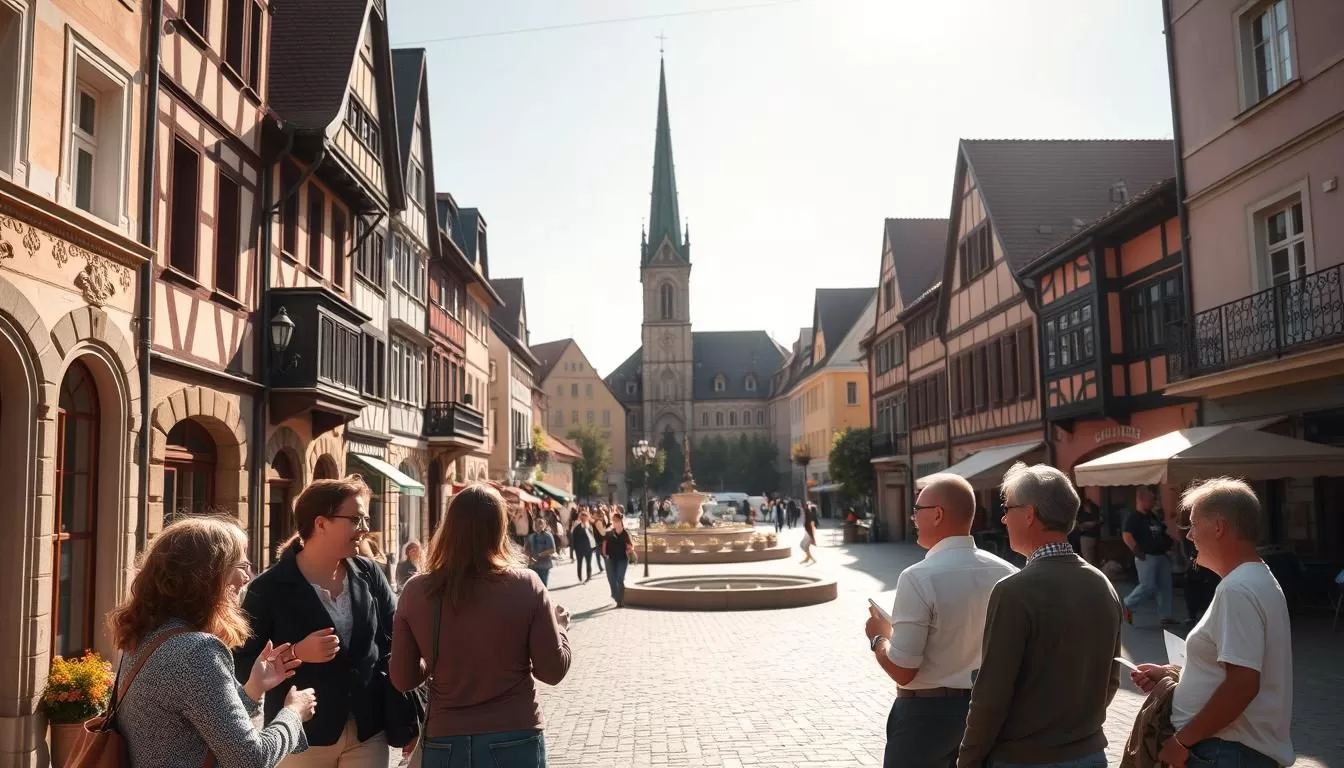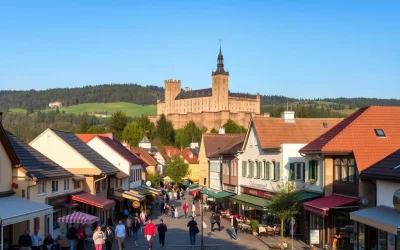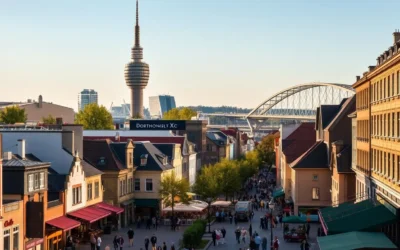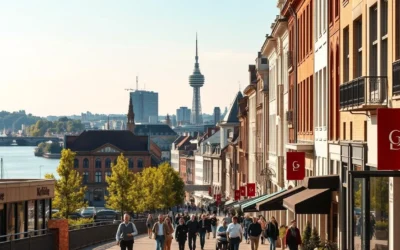✓ Accommodations ✓ Flights ✓ Rental Cars
When you think of communication in this region, Standard German stands out as the foundation. It’s the official language, deeply rooted in everyday life. This standardized form of the German language plays a vital role in education, media, and government.
The origins of this language trace back to historical developments, shaping the cultural identity of the area. With its rich dialects, it reflects a unique heritage. Whether you’re exploring local traditions or engaging with the community, understanding its linguistic roots offers a deeper connection.
From classrooms to public spaces, the influence of Standard German is undeniable. It’s more than just a way to communicate—it’s a symbol of unity and tradition.
Overview of Language Diversity in Thuringia
Exploring the linguistic landscape reveals a fascinating mix of dialects and influences. This area is home to a vibrant blend of standard and local speech patterns. The coexistence of these elements reflects the region’s rich cultural heritage.
Migration has played a significant role in shaping the linguistic mosaic. Over the years, immigrant communities have brought their languages, adding to the diversity. This blend of voices creates a unique communication style that is both traditional and modern.
Statistical insights highlight the population’s linguistic variety. Over 95% of people speak Standard German or a variant. However, minority and regional languages also contribute to the area’s identity.
The balance between standard language and local dialects is striking. While Standard German dominates formal settings, dialects thrive in everyday conversations. This duality enriches the cultural fabric of the region.
“Language is the roadmap of a culture. It tells you where its people come from and where they are going.”
Minority and immigrant languages play a vital role in promoting cultural diversity. They preserve traditions and foster inclusivity. This linguistic richness is a testament to the area’s evolving identity.
| Language Type | Percentage of Speakers |
|---|---|
| Standard German | 95% |
| Regional Dialects | 20% |
| Immigrant Languages | 5% |
Understanding this linguistic diversity offers a deeper connection to the region. It’s not just about communication—it’s about identity, tradition, and unity.
Historical Evolution of German in Thuringia
The journey of language in this region is a tale of transformation. Over centuries, it has evolved from ancient dialects to the modern speech we know today. This evolution reflects the area’s rich cultural and historical shifts.
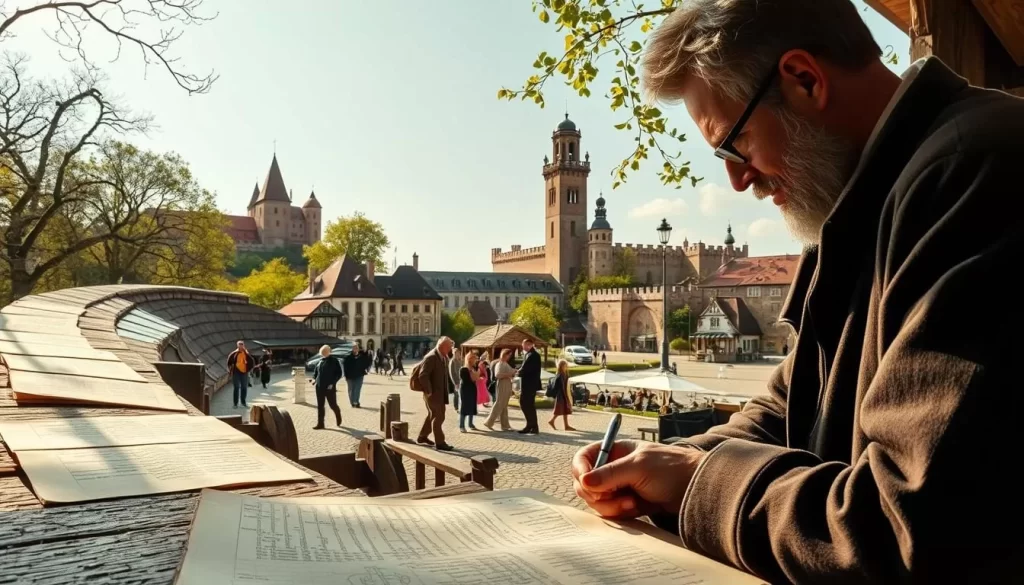
Old and Middle High German Roots
The roots of the language trace back to the Old High German period, which lasted until the 11th century. During this time, diverse dialects flourished, each shaped by local traditions and influences. These early forms laid the foundation for future linguistic developments.
By the 12th century, Middle High German emerged, becoming the language of literature and poetry. This stage marked significant changes in phonetics and grammar. It was a time when language began to unify, paving the way for modern standards.
Transition to Modern Standard German
The shift to Modern Standard German was influenced by key historical events. Martin Luther’s Bible translation in the 16th century played a pivotal role. His work helped standardize the language, making it accessible to a broader audience.
Over time, migrations and cultural shifts further shaped the language’s form. Today, the region’s linguistic identity is a blend of tradition and modernity. This evolution highlights the enduring power of language to connect people across generations.
“Language is the mirror of a society’s soul, reflecting its past and shaping its future.”
| Language Stage | Time Period |
|---|---|
| Old High German | Until 11th Century |
| Middle High German | 12th-14th Century |
| Modern Standard German | 16th Century Onward |
Thuringia, Germany: Official and widely spoken languages
Communication in this area reflects a blend of tradition and modernity. Standard German remains the cornerstone, used in schools, workplaces, and public spaces. Its widespread acceptance ensures it’s the primary mode of interaction.
Local speech varieties, like Low German, add a unique flavor to everyday conversations. These dialects are deeply rooted in regional traditions. They thrive in informal settings, offering a glimpse into the area’s cultural heritage.
The coexistence of standard and dialect forms highlights the region’s linguistic richness. While Standard German dominates formal contexts, dialects like Low German maintain their presence in rural areas. This balance creates a vibrant linguistic landscape.
“Language is the soul of a community, preserving its past while shaping its future.”
Regional traditions play a key role in sustaining these speech patterns. Festivals, local media, and family gatherings often feature dialects. This blend of standard and local speech ensures that the area’s linguistic identity remains dynamic and inclusive.
In both urban and rural settings, the concept of a widely spoken language is evident. Whether you’re in a bustling city or a quiet village, the influence of Standard German and its dialects is unmistakable. This linguistic diversity is a testament to the region’s evolving cultural identity.
The Role of Standard German in Education and Daily Life
Standard German plays a central role in shaping education and daily interactions. It serves as the foundation for learning, communication, and cultural identity. Whether in classrooms or casual conversations, its influence is undeniable.
Impact on School Curriculum
In schools, Standard German is the primary language of instruction. Textbooks, exams, and official communications all adhere to its rules. This ensures consistency and clarity in learning.
Students are taught grammar, vocabulary, and pronunciation that align with the standard form. This helps them develop strong language skills. It also prepares them for higher education and professional environments.
Teachers emphasize the importance of mastering Standard German. They use it to explain complex concepts and encourage students to express themselves clearly. This focus on language proficiency supports academic success.
Everyday Communication Trends
Beyond the classroom, Standard German dominates media and public spaces. News broadcasts, official documents, and social interactions rely on it. This widespread use reinforces its importance in daily life.
While regional dialects add flavor to conversations, Standard German ensures mutual understanding. It bridges gaps between different speech communities. This balance between tradition and modernity enriches communication.
Young people, in particular, benefit from this standardization. It helps them navigate diverse social and professional settings. Whether texting friends or attending job interviews, Standard German is their go-to language.
| Aspect | Role of Standard German |
|---|---|
| Education | Primary language of instruction |
| Media | Used in news and official communications |
| Daily Conversations | Ensures mutual understanding |
Standard German is more than just a language—it’s a tool for connection and growth. Its role in education and daily life highlights its enduring significance.
Exploring German Dialects in Thuringia
Delving into the speech patterns of this area reveals a rich tapestry of linguistic diversity. The local dialect spoken here carries unique characteristics that set it apart from Standard German. These speech variations are not just about words—they reflect the region’s cultural identity.
Local Dialect Characteristics
The local dialect in this region is known for its distinct pronunciation and vocabulary. For example, certain vowels are pronounced differently, giving the speech a melodic quality. Words often have unique endings or contractions, making the dialect instantly recognizable.
Everyday phrases in the dialect spoken here often differ from Standard German. For instance, “Guten Tag” might become “Gud’n Tach.” These small changes add a personal touch to conversations. They also highlight the region’s cultural heritage.
Comparisons with Low German and High German
When comparing this local dialect to broader categories like Low German and High German, key differences emerge. Low German, spoken in northern regions, has a simpler grammar structure. High German, on the other hand, is more formal and standardized.
The pronunciation in this area’s dialect often aligns more closely with High German. However, it retains unique features that distinguish it from both categories. This blend of influences creates a speech pattern that is both familiar and distinct.
| Dialect Type | Key Features |
|---|---|
| Local Dialect | Unique pronunciation, regional vocabulary |
| Low German | Simpler grammar, northern influence |
| High German | Formal, standardized pronunciation |
Understanding these variations offers a deeper appreciation for the region’s linguistic richness. Whether you’re learning the dialect spoken here or simply listening, it’s a journey into the heart of local culture.
Impact of Mass Education and Migration on Dialects
The way we speak is shaped by the world around us. Mass education and migration have significantly influenced dialects, blending tradition with modernity. These forces have both preserved and transformed linguistic diversity.
Standardized education has played a key role in reducing regional dialect differences. Schools emphasize Standard German, creating a common linguistic ground. This shift has blurred the lines between local speech patterns, making them less distinct over time.
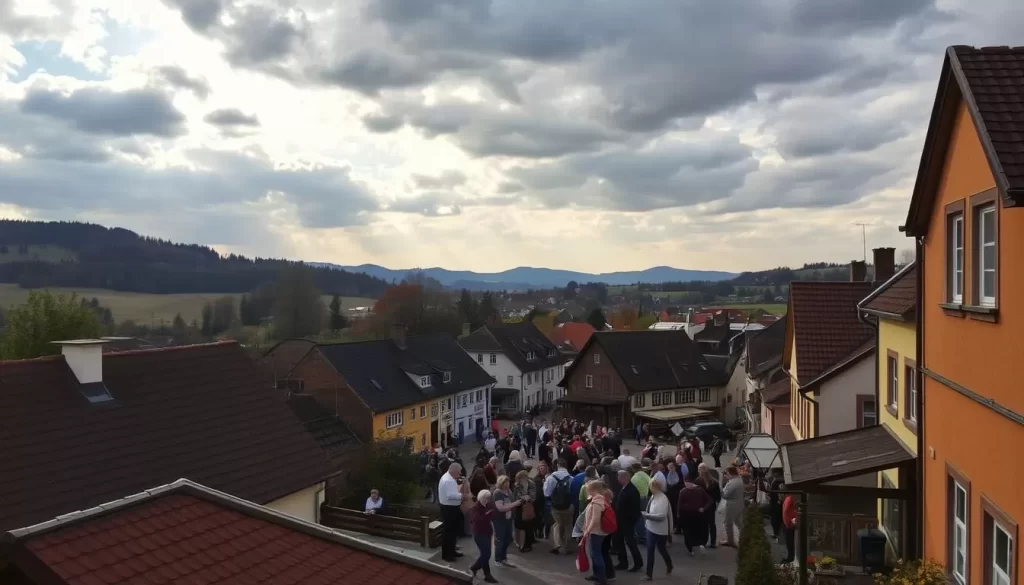
Migration introduces new linguistic elements, enriching the local language. Immigrants bring their second language and cultural expressions, which blend into the existing dialect. This fusion creates a dynamic linguistic landscape, reflecting the area’s evolving identity.
Exposure to foreign languages also contributes to language change. People learn new words and phrases, which gradually enter everyday speech. This process highlights the adaptability of language in a globalized world.
Despite these influences, subtle differences persist. Regional dialects retain unique features, preserving cultural heritage. These distinctions matter because they connect people to their roots and traditions.
“Language is a living entity, shaped by history and shaped by us.”
| Factor | Impact on Dialects |
|---|---|
| Mass Education | Reduces regional dialect diversity |
| Migration | Introduces new linguistic elements |
| Foreign Language Exposure | Encourages language adaptation |
Understanding these changes helps us appreciate the resilience of dialects. They are more than just speech—they are a testament to cultural identity and evolution.
Cultural Heritage: Language and Identity in Thuringia
Language serves as a bridge between the past and present, connecting generations. In this area, it’s more than just a way to communicate—it’s a reflection of cultural identity. The words you hear in everyday conversations carry the weight of history and tradition.
The Indo-European language family plays a key role in shaping local speech patterns. Its influence is evident in the way people express themselves, preserving ancient roots while adapting to modern life. This linguistic heritage is a source of pride for many families.
Regional identity is deeply tied to language. Across different areas and states, dialects act as markers of belonging. They connect people to their roots, fostering a sense of community and continuity. Whether in urban centers or rural villages, language unites.
Family traditions often revolve around language. Stories passed down through generations keep cultural values alive. These practices strengthen bonds and ensure that heritage remains vibrant. It’s not just about words—it’s about preserving a way of life.
“Language is the thread that weaves the fabric of culture, binding us to our past and guiding us into the future.”
Preserving dialects is essential for maintaining cultural continuity. They are a living testament to the area’s rich history. By valuing these speech patterns, you honor the legacy of those who came before. Language is more than a tool—it’s a treasure.
Comparing Regional and Minority Languages
Language diversity in this region offers a unique blend of tradition and modernity. Regional dialects and minority languages coexist, creating a vibrant linguistic landscape. Each speaker contributes to this rich tapestry, shaping the way people communicate daily.

Recognized Minority Languages in Context
Minority languages hold a special place in the cultural fabric of this area. For instance, Lower Sorbian and Low German are protected under state initiatives. These languages are not just tools for communication—they are symbols of heritage and identity.
In many cases, minority languages are preserved through education and media. Schools teach these languages, ensuring they are passed down to younger generations. This effort helps maintain cultural continuity in a rapidly changing world.
Influence of Immigrant Languages
Immigrant communities bring their languages, adding to the region’s linguistic diversity. Urban areas, in particular, see a mix of traditional and immigrant speech patterns. This blend enriches the local culture and fosters inclusivity.
For example, a German speaker might hear Turkish or Arabic in daily interactions. These languages influence local dialects, creating a dynamic communication style. This exchange highlights the adaptability of language in a multicultural setting.
“Every person’s language choice shapes the collective identity of a community.”
Understanding these influences helps you appreciate the region’s linguistic richness. Whether you’re a native speaker or a newcomer, your language contributes to this evolving cultural mosaic. For more insights, explore Germany’s efforts to protect regional languages.
Influences from Historical Events on Language Development
The evolution of language is deeply tied to the events that shaped history. From ancient migrations to cultural revolutions, each year brought changes that molded the way people communicate. Understanding these influences helps you appreciate the richness of modern speech patterns.
One of the earliest influences came from the Germanic tribes. These groups, originating from the Bronze Age, laid the foundation for the german german-speaking world. Their dialects evolved into what we now recognize as Old High German, marking a significant shift in linguistic history.
The Role of Germanic Tribes
The Germanic tribes played a pivotal role in shaping early language. Their migration patterns, especially during the 19th century, brought new words and expressions into the region. This blending of dialects created a dynamic linguistic landscape that continues to evolve today.
Key events, like the High German consonant shift, further transformed the language. This shift, which occurred around the 6th year, altered pronunciation and grammar, setting the stage for modern German. These changes were not just linguistic—they reflected broader cultural shifts.
“Language is the living record of history, preserving the voices of those who came before.”
Another major milestone was Martin Luther’s translation of the Bible in the 16th year. His work standardized the language, making it accessible to a wider audience. This effort bridged regional dialects and fostered a sense of unity among german german-speaking communities.
By the 19th century, the rise of mass education and media further solidified these changes. Schools taught Standard German, while newspapers and books spread its use. This era marked a turning point in how people communicated, blending tradition with modernity.
Today, the influence of these historical events is still evident. Whether you’re speaking or listening, the echoes of the past shape every word. Understanding this history offers a deeper connection to the language and its cultural roots.
Media, Communication, and Language Standardization
The rise of mass communication has transformed how languages evolve and unify. From newspapers to television, media has played a key role in spreading High German across regions. This standardization ensures clarity and consistency in formal settings.

Urban centers, especially in major cities, have been hubs for language concentration. Media outlets in these areas reinforce linguistic norms, making High German the default for public communication. This influence bridges regional differences, creating a shared understanding.
Communication technologies, like radio and the internet, further strengthen language standards. They provide platforms where High German dominates, ensuring its widespread use. This balance between standardization and regional dialects enriches the linguistic landscape.
“Media is the mirror of language, reflecting its evolution and shaping its future.”
The shared language family of German dialects has also contributed to this process. It provides a foundation for consistency, allowing regional variations to thrive alongside standardized forms. This duality highlights the adaptability of language in a modern world.
| Factor | Impact on Language |
|---|---|
| Media | Spreads and standardizes High German |
| Urban Centers | Concentrate language influences |
| Communication Technologies | Reinforce language norms |
Understanding these dynamics helps you appreciate the role of media in shaping language. It’s not just about communication—it’s about unity, tradition, and progress.
Educational Trends and Foreign Language Acquisition
Education in this part of the country reflects a globalized approach to learning. Schools are increasingly integrating foreign languages into their curricula, preparing students for a connected world. This shift is not just about language skills—it’s about cultural understanding and adaptability.
The system emphasizes bilingual education, with many schools offering programs in English, French, or Spanish. These programs are designed to enhance cognitive abilities and broaden students’ horizons. Studies show that early exposure to a second language improves problem-solving skills and creativity.
Influences from southern Germany are evident in curriculum design. Educators often incorporate cultural elements from this region, enriching the learning experience. This approach ensures that students not only learn a language but also appreciate its cultural context.
Educational policies play a key role in promoting language diversity. The government supports initiatives that encourage multilingualism, ensuring that students are well-prepared for global opportunities. This focus on language acquisition is reshaping the educational landscape.
“Learning a new language is like opening a door to a new world—it broadens your perspective and deepens your understanding.”
As the system evolves, so do the methods of teaching. Interactive tools, such as language apps and online platforms, are becoming a part of everyday learning. These innovations make language acquisition more engaging and accessible.
In this country, the integration of foreign languages into education is more than a trend—it’s a necessity. By embracing linguistic diversity, schools are preparing students for a future where communication knows no borders.
Modern Linguistic Features in Thuringia
Modern language features in this area blend tradition with innovation. Today’s speech patterns reveal a mix of old and new influences, creating a vibrant linguistic landscape. From pronunciation to vocabulary, the way people speak reflects both history and current trends.
Pronunciation and Dialect Variation
One key question is: what makes modern dialects unique? The answer lies in their subtle differences. For example, vowel sounds in certain words might vary slightly, giving each dialect its distinct flavor. These variations add richness to everyday conversations.
The range of dialect differences is impressive. From urban centers to rural villages, you’ll notice unique accents and inflections. These small changes contribute to regional identity, making each area’s speech pattern special.
“Language is the music of a culture, and every dialect adds its own note to the melody.”
Another question to consider is how these variations persist in a globalized world. Despite the influence of mass media, local dialects thrive in informal settings. They are a testament to the resilience of cultural heritage.
The range of pronunciation patterns also highlights the adaptability of language. Whether it’s a slight shift in tone or a unique word ending, these features make everyday speech dynamic and engaging.
| Feature | Impact on Language |
|---|---|
| Pronunciation | Adds regional identity |
| Dialect Variations | Enhances cultural richness |
| Accent Differences | Creates unique speech patterns |
Understanding these modern linguistic features helps you appreciate the region’s evolving identity. Whether you’re listening to a local conversation or speaking yourself, these subtle differences connect you to the area’s cultural roots. For more insights, explore the Thuringian dialect and its unique characteristics.
Central Role of Language in Thuringian Regional Identity
Language acts as the heartbeat of regional identity, weaving together history and community. In this area, it’s more than just a way to communicate—it’s a symbol of pride and unity. The use of High German in formal settings reflects its importance as a cultural cornerstone.
In every city, you’ll find a blend of tradition and modernity in the way people speak. High German connects urban centers, ensuring clear communication across diverse communities. At the same time, local dialects thrive in rural areas, preserving unique cultural expressions.
The shared traits of the language family strengthen community bonds. Whether in schools, workplaces, or family gatherings, language serves as a bridge between generations. It’s a living testament to the region’s rich heritage.
“Language is the thread that ties us to our roots, reminding us of who we are and where we come from.”
Stories passed down through generations highlight the enduring power of language. These narratives keep traditions alive, ensuring that cultural identity remains vibrant. By preserving linguistic heritage, communities honor their past while embracing the future.
Language is not just a tool—it’s a treasure. It unites people, fosters pride, and reflects the soul of the region. Whether you’re in a bustling city or a quiet village, the words you hear tell a story of resilience and connection.
Conclusion
Language is a living reflection of culture, shaped by history and innovation. From the roots of the Indo-European language family to modern speech patterns, it tells a story of unity and diversity. Standard forms ensure clear communication, while regional dialects preserve unique identities.
Learning a second language or exploring a foreign language opens doors to new perspectives. It enriches daily interactions and fosters global connections. The subtle differences in dialects remind us of the beauty in linguistic variety.
As language evolves, it continues to honor its heritage. Whether you’re speaking or listening, every word connects you to a rich cultural tapestry. Embrace this diversity, and let it inspire your journey into the heart of communication.
The above is subject to change.
Check back often to TRAVEL.COM for the latest travel tips and deals.
